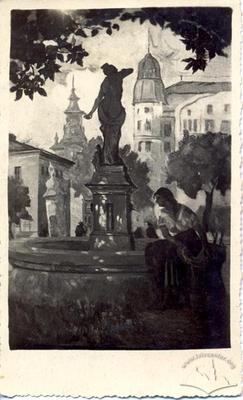
Fountain "Svitezyanka"
- ID: 165
- Place: Lviv
- Date: 1941-1944
City Theatre (other names: Opera, Grand Theatre, Opera House, Ivan Franko State Academic Opera and Ballet Theatre in Lviv, Solomia Krushelnytska State Academic Opera and Ballet Theatre in Lviv) has been the pride and one of the crucial visual points of downtown Lviv for over a century. For a long time the Skarbek Theatre provided for the needs of the viewers. The Skarbek Theatre was constructed in 1839-1842. The period specfied by Stanisław Skarbek's foundational deed ran out in 1892. The city council of the provincial capital city of Lviv passed a resolution in 1896 to build a new theatre, one that would correspond to the city's status, as well as to the ambitions of the city's residents. After many options were considered, it was decided to construct the theatre in Gołuchowskis Square. This led to a search for a solution to the issue of underground plumbing. The project was elaborated by the architect Zygmunt Gorgolewski, a professor and head of the Industry School, as well as winner of 2nd prize in the competition of construction projects of the Berlin Reichstag. Construction of the new theatre was undertaken by the company of architect Ivan Levynskyi in 1897-1900. The main, southern, façade faces the axis of the Hetman Bulwarks. It is richly decorated and crowned by a triangular fronton with bas-reliefs by Antoni Poppel. Above the fronton bronze winged allegoric figures by sculptor Petro Viytovych have been placed. The central figure is Glory with a gilded palm branch, to the left is Drama (with a mask), to the right – Music (with a lyre). A gallery with an arc covering, creates the rhythm of the second level. On either side of the gallery are allegoric sculptures of Tragedy (with a sword in hand) by A. Poppel, and Comedy by Tadeusz Barącz. Three oaken doors, each two meters (about six ft.) wide, lead into the House.